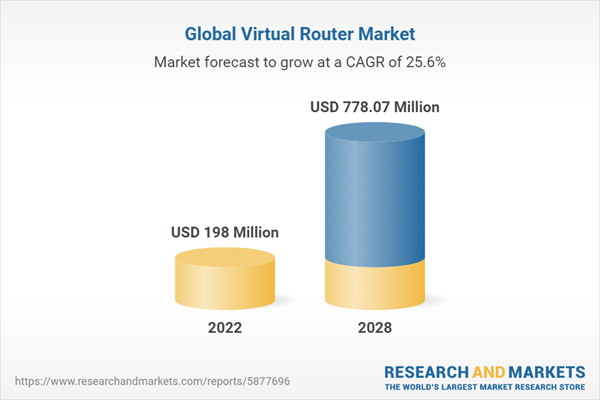Speak directly to the analyst to clarify any post sales queries you may have.
10% Free customizationThis report comes with 10% free customization, enabling you to add data that meets your specific business needs.
Additionally, the market for virtual routers is positively impacted by the rise in IoT usage, increased system availability, rapid digitalization, rise in linked devices, and shift in consumer choice. Additionally, the rise in demand for private clouds and the use of virtual router technology by small and medium-sized businesses provide lucrative prospects to market participants during the projection period.
A software-based routing system called a virtual router allows the host computer to function across a local area network much like a standard hardware router. It is scalable and adaptable. The last byte of the address contains a special virtual router identifier (VRID) that serves as its identification. A virtual router has a wide range of uses in the global telecommunications sector since it can reduce hardware costs, speed up the development of new applications, and process packets in real-time.
Increased Demand for Service Providers to Increase Network Agility and Effectively Scale Out
Increased need for more effective scale-out and improved network agility is anticipated to fuel market expansion. The edge network of communication service providers can easily and quickly scale up their bandwidth and services thanks to virtual routing (CSPs). On its network edge, CSPs use a mix of hardware routers and appliances. This deployment architecture is typically geared for centralised service delivery and high traffic volumes. For low-bandwidth applications, though, this can be ineffective and expensive, posing an artificial barrier to entry for new services and markets. Thus, CSPs feel the necessity to deploy virtual routers for dispersed edge designs and agile service of lower bandwidth applications. Virtual routers are also used for low-risk growth into new markets and regions as well as short-term service requirements related to unique events. Additionally, as a component of managed service offerings, as well as in the transition to NFV and SDN, communication service providers utilise virtual routers to offload control plane-intensive protocols from physical routers. In order to offer specialised services, virtual routers, for example, can be deployed as a VNF on a COTS server together with other VNFs enabling firewall, application acceleration, IPsec, network address translation, and others. With this strategy, Layer 3 CPEs are swapped out with less expensive, simpler Layer 2 CPE devices, resulting in cheaper capex and opex.Demand for Lower Total Cost of Ownership (TCO)
Since they offer so many advantages over traditional routers, virtual routers are a highly effective solution. For instance, reducing an organization's capex and opex will reduce the total cost of ownership (TCO).
Equipment, operational, and facility costs can be decreased with the use of cloud-based virtual routers. Additionally, network functions virtualization (NFV) and cloud computing can help manage rapid demand growth while lowering capital and operating costs (capex and opex). Thus, service providers are giving it more consideration. These savings significantly reduce the total cost of ownership (TCO) for service providers and boost agility, both of which are essential for thriving in the current difficult telecom environment. Additionally, virtualizing programmes makes complex procedures simpler, increasing agility and adaptability. Examples include scaling, healing, and software upgrades.
Market Segmentation
Global Virtual Router market is segmented by component, type, and end users. On the basis of component, the market is further segmented into solution and service. On the basis of type, the market is further divided into Custom and Predefined. On the basis of end users, market is further segmented into Service Providers and Enterprises.Market Players
Major market players in the global Virtual Router market are Juniper Networks, Inc, Telefonaktiebolaget LM Ericsson Broadcom Inc., 6WIND, Huawei Technologies Co., Ltd., Hewlett Packard Enterprise Development LP, IBM Corporation, Cisco Systems, Inc., Nokia Corporation, 128 Technology.Report Scope
In this report, the Global Virtual Router market has been segmented into the following categories, in addition to the industry trends which have also been detailed below:Virtual Router Market, by Component
- Solution
- Service
Virtual Router Market, by Type
- Custom
- Predefined
Virtual Router Market, by End Users
- Service Providers
- Enterprises
Virtual Router Market, by Region:
- North America
- Asia-Pacific
- Europe
- South America
- Middle East
Competitive Landscape
Company Profiles: Detailed analysis of the major companies present in the Global Virtual Router market.Available Customizations
The following customization options are available for the report:- Detailed analysis and profiling of additional market players (up to five).
This product will be delivered within 1-3 business days.
Table of Contents
Companies Mentioned
- Juniper Networks, Inc.
- Telefonaktiebolaget LM Ericsson
- Broadcom Inc.
- 6WIND
- Huawei Technologies Co. Ltd.
- Hewlett Packard Enterprise Development LP
- IBM Corporation
- Cisco Systems, Inc.
- Nokia Corporation
- Technology
Table Information
| Report Attribute | Details |
|---|---|
| No. of Pages | 180 |
| Published | September 2023 |
| Forecast Period | 2022 - 2028 |
| Estimated Market Value ( USD | $ 198 Million |
| Forecasted Market Value ( USD | $ 778.07 Million |
| Compound Annual Growth Rate | 25.6% |
| Regions Covered | Global |
| No. of Companies Mentioned | 10 |









